If you’re someone who loves old buildings and history, it can be really disheartening to watch a gorgeous historic structure fall apart over time, losing its charm and significance. That’s why we’re excited to share some uplifting stories with you! In this collection, we highlight mansions, castles, and other historic homes that were on the brink of destruction but were saved from decay. Thanks to restoration efforts, these architectural gems have been brought back to life, ready to be appreciated by generations to come. Curious to see the incredible transformations for yourself? Just click or scroll ahead, and let’s explore together!
Clifden Terrace
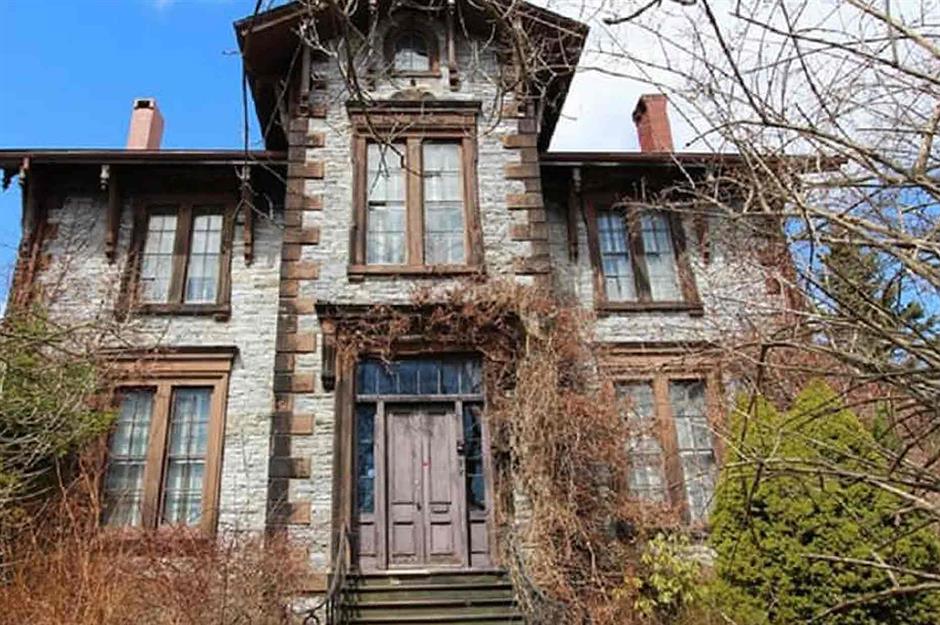
In the early 1820s, William Parks, an entrepreneur from Ireland, relocated to New Brunswick, Canada. He became a notable figure in the Irish-Presbyterian community in Saint John and in 1856, he constructed a striking two-storey Gothic Revival home using locally quarried stone. This impressive house was named Clifden Terrace.
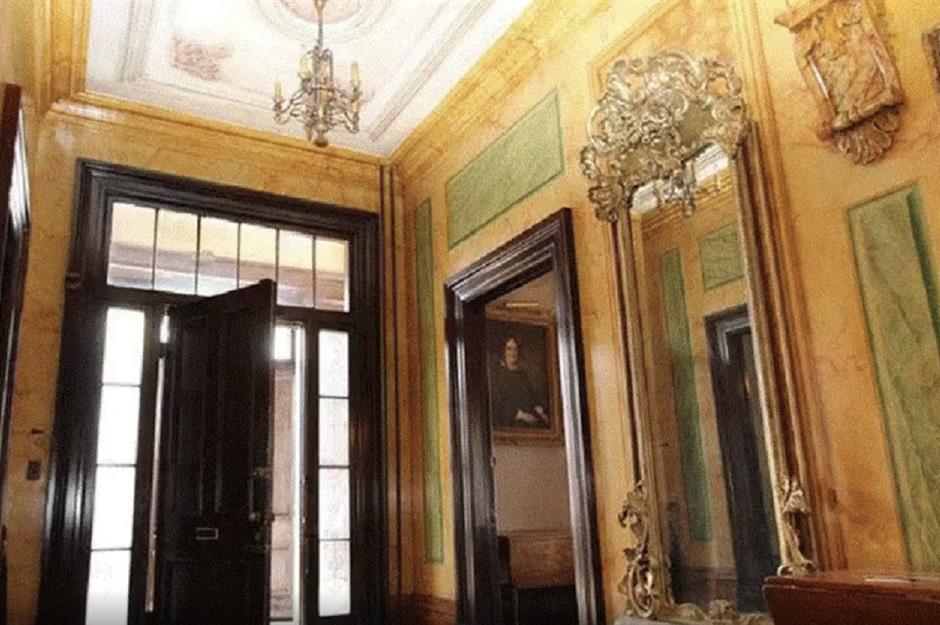
Over time, nature started to reclaim the exterior of the house, but its grandeur and imposing presence are still evident today. Inside, the layout of the house follows the typical design of cottages from that era, featuring double parlours on the main floor, a grand library, and a dining room. Remarkably, although Clifden Terrace didn’t originally have gas lighting, it did have indoor plumbing, which was quite luxurious for its time. Even today, the property reportedly retains its original copper tub and marble wash basin.
After William Parks passed away in 1870, the house remained in the family until it was sold at auction in 1955. Unfortunately, neglect over the years took its toll on the property until it underwent a sensitive restoration and reopened to guests in 2021, now known as Clifden Manor.
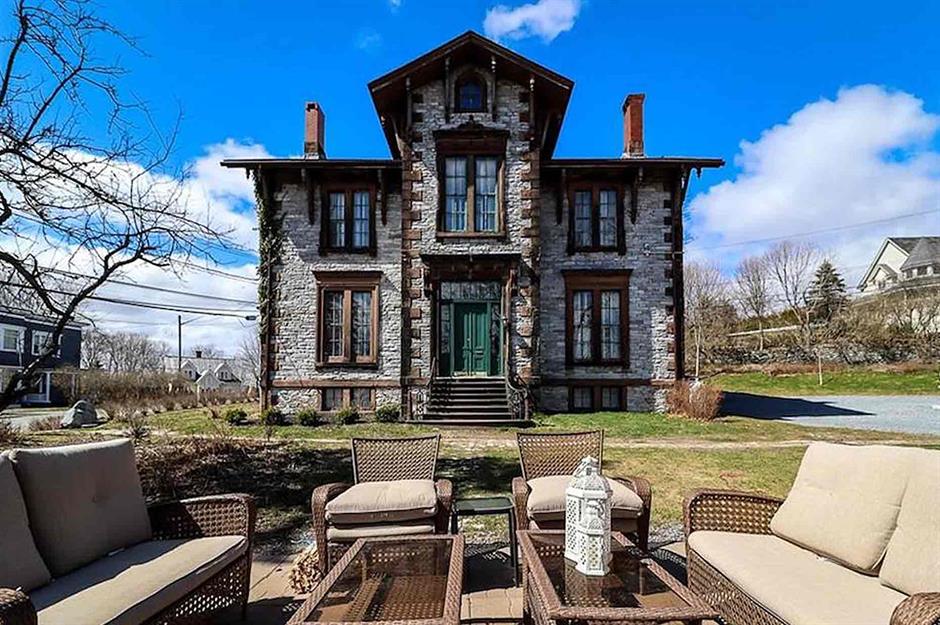
Clifden Manor has undergone extensive renovations to meticulously restore the historic building to its former splendor. It now offers seven beautifully appointed bedrooms and has been described as “meticulously modernized for today’s lifestyle” while preserving the “original beauty of fine craftsmanship.” Operating as a boutique bed and breakfast, it provides visitors with a luxurious accommodation option in Saint John.
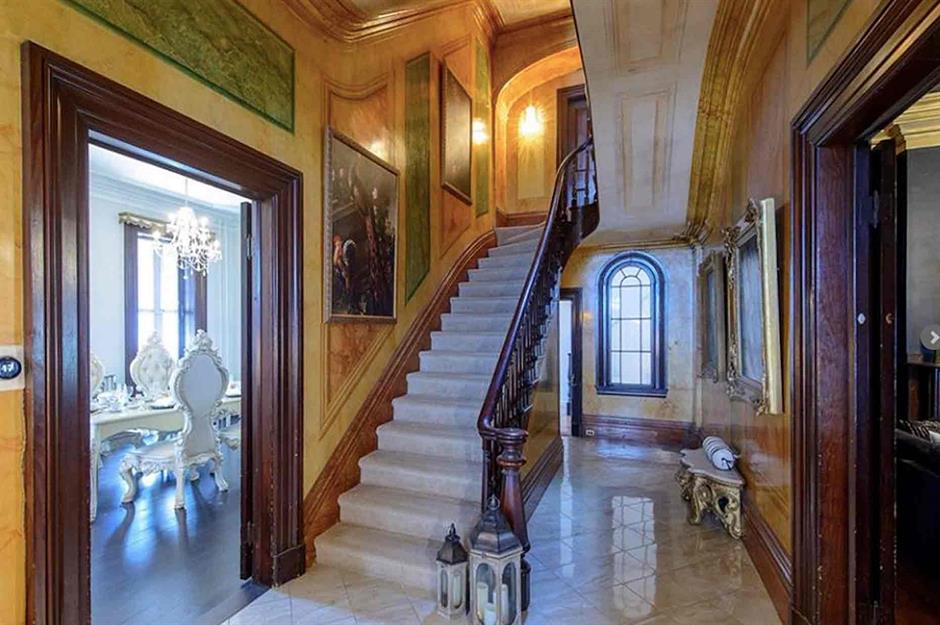
The house, which still retains its stately sandstone exterior, features impressive interior details such as a marble hall with trompe l’oeil detailing, gold leaf embellished cornicing and mouldings, and remnants of the 1955 auction collection, including a vast array of old mahogany furniture, silverware, china, glassware, and even one of Canada’s rarest stamps.
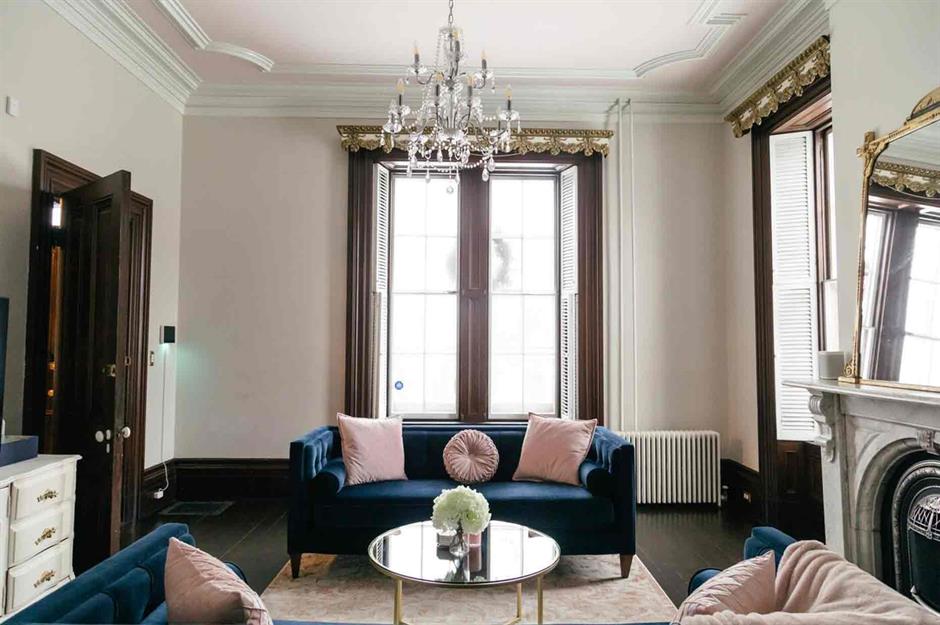
Despite the changes it has seen over the years, Clifden Terrace’s historic charm and elegance have been meticulously preserved throughout its spacious 7,500 square feet of living space. The renovated residence boasts towering ceilings, sparkling chandeliers, nine fireplaces, a large kitchen, and dedicated workspaces. One of its most fascinating features, the central belvedere viewing gallery, remains intact and offers guests a glimpse into the home’s Regency-style origins.
If you’re interested in experiencing this beautifully restored piece of Canadian history, Clifden Manor is available for bookings on Airbnb.
Selma Mansion
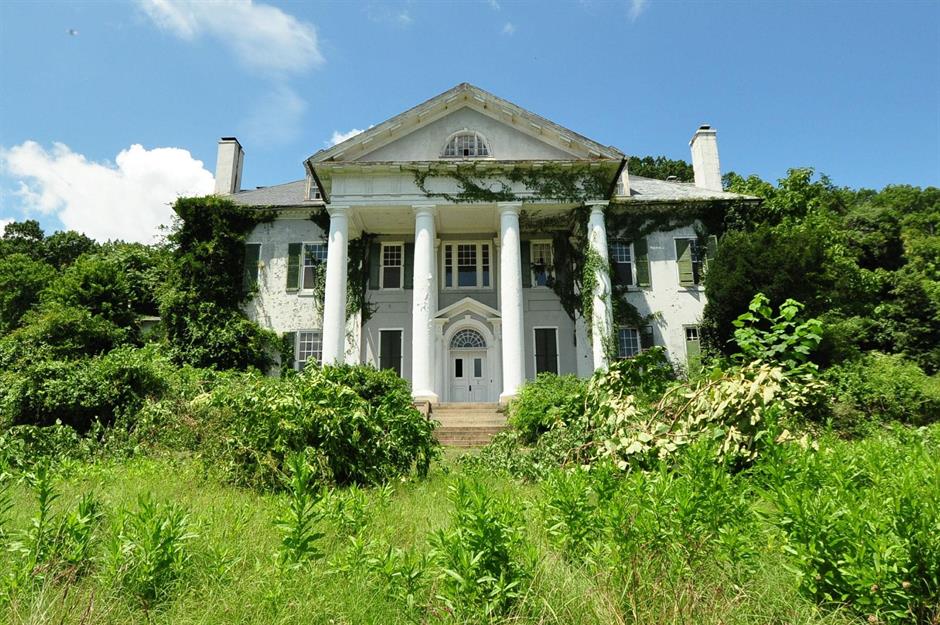
Even as nature began to reclaim its territory, the remnants of this remarkable mansion retained their imposing presence. Originally commissioned by banker Elijah B. White after a previous structure was destroyed by fire, this magnificent Colonial Revival home in Leesburg, Virginia was designed by architects Noland and Baskervill in 1902. A true trendsetter, it was among the first of its kind in the area, boasting a grand tetrastyle Roman Doric portico and an elegant triangular pediment.
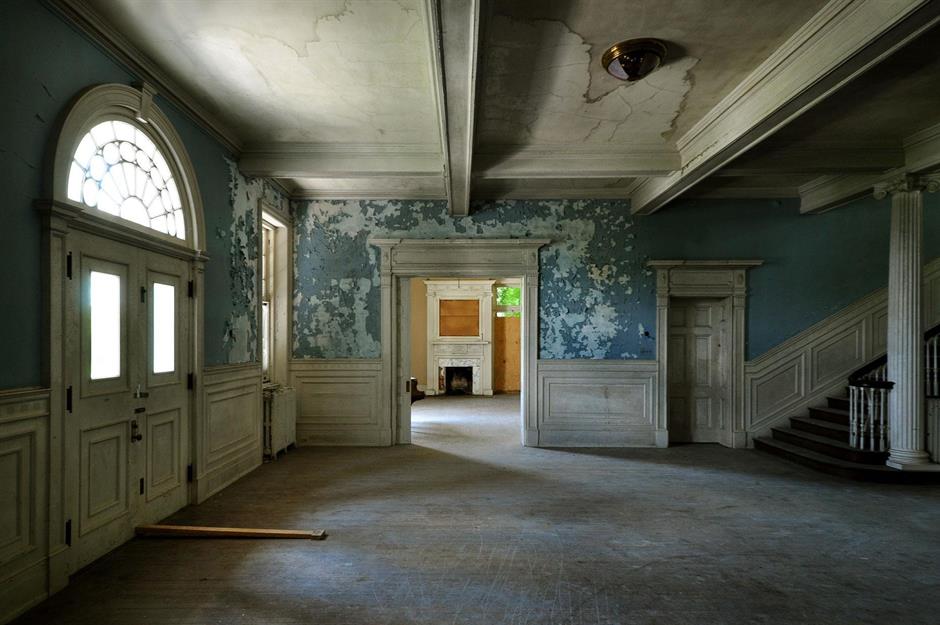
Despite its dilapidated state, the mansion still hints at its former luxurious interior, particularly evident in the graceful wood-paneled entrance hall crafted by the skilled artisans, the Norris Brothers of Leesburg. During its heyday in the 1920s, the house exuded glamour and sophistication, often gracing the society pages of glossy magazines as the White family hosted gatherings for political elites within its walls. The property remained in the White family until 1970, later passing to the care of the Epperson family, who tended to Selma, as it was affectionately known, for nearly three decades. However, neglect set in after it was sold to a foreign investor, leading to its gradual decay.
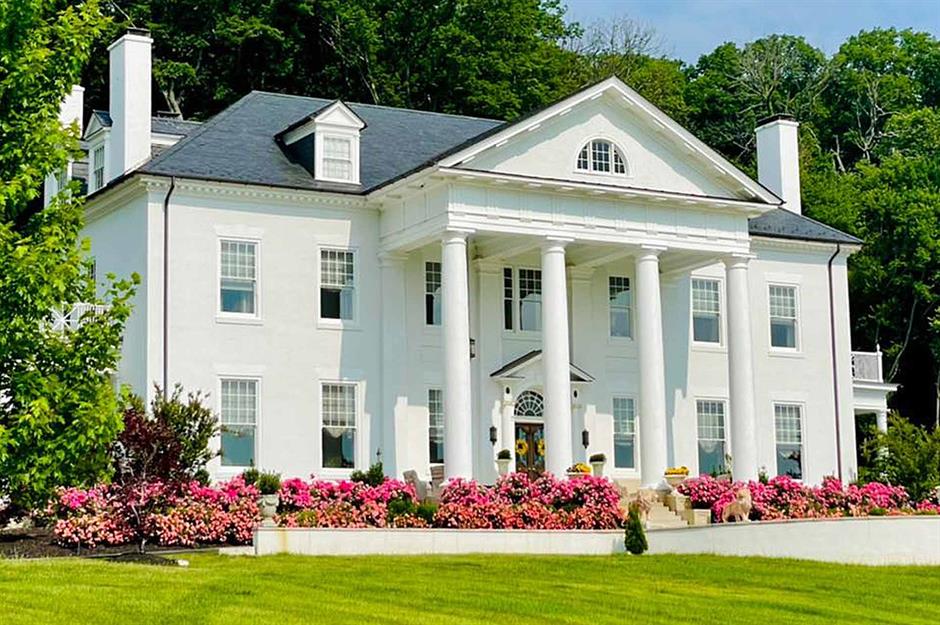
By 2007, the mansion had stood empty for 16 years, becoming a target for vandals and ghost hunters and landing on Preservation Virginia’s list of Most Endangered Historic Places. Fortunately, Selma Mansion found its savior in business leader and history enthusiast Sharon Virts and her husband, who embarked on a comprehensive restoration project. The once-peeling white stucco covering the brick exterior was meticulously restored, alongside the grand staircase leading to the portico, revealing the mansion’s magnificent symmetry, with end chimneys framing the hipped roof.

Inside, the transformation is equally remarkable. Following an impressive renovation, the mansion has regained its regal status. A neutral paint scheme in the hallway accentuates the beauty of the curved archways, while the spacious interior boasts nine bedrooms, seven bathrooms, racehorse stables, and even an intercom system to accommodate the grandest of guests.
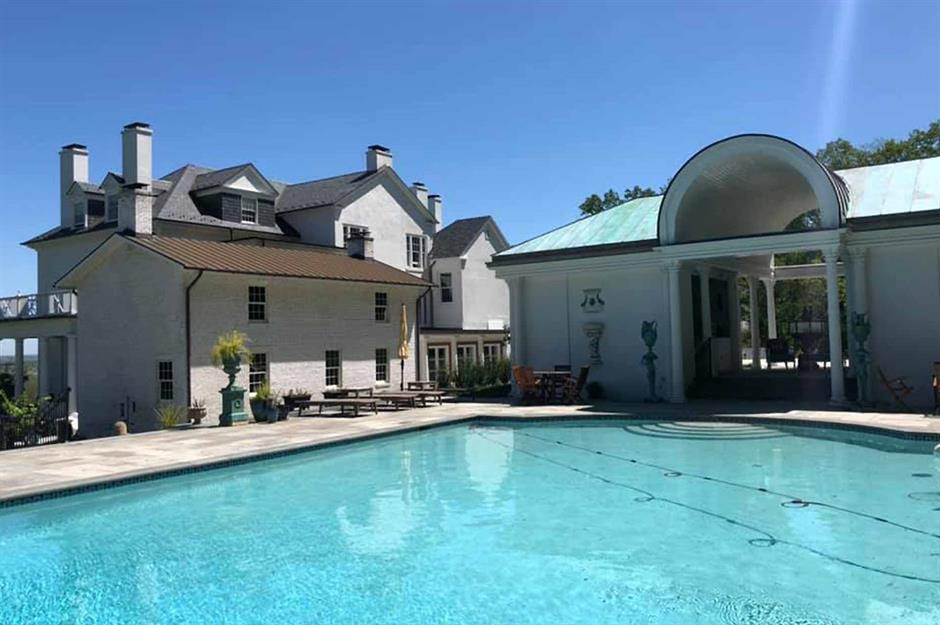
Although the mansion’s original pool was beyond salvage, it was relocated to the rear of the property. The Virts family purchased Selma for $1.2 million (£1m) and meticulously followed old architectural blueprints to stay faithful to the original design during the $5 million (£4.3m) renovation, which spanned two years. It stands today as a testament to their dedication and an incredible achievement in historic preservation.
Rockwell House
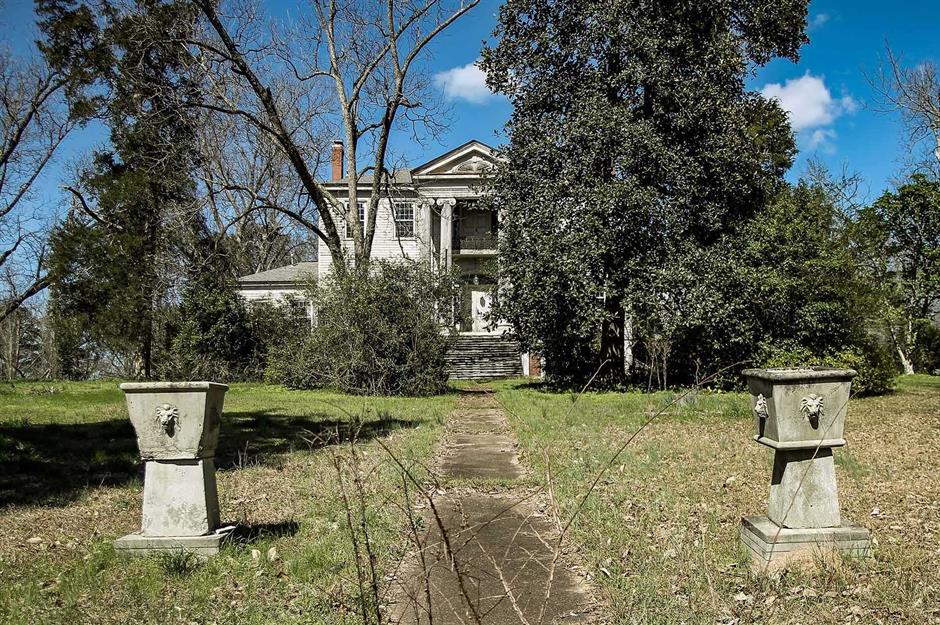
Tucked away in Milledgeville, Georgia, Rockwell House had been slowly succumbing to neglect for over 70 years, hidden behind overgrown shrubbery. It’s heartbreaking to see such a stunning house meet such a fate. Designed by architect Joseph Lane in 1838, captured here by Leland Kent of Abandoned Southeast, it was once the pinnacle of elegance. Built in the neo-classical Federal style with Greek Revival elements for Colonel Samuel Rockwell, its grandeur was undeniable.
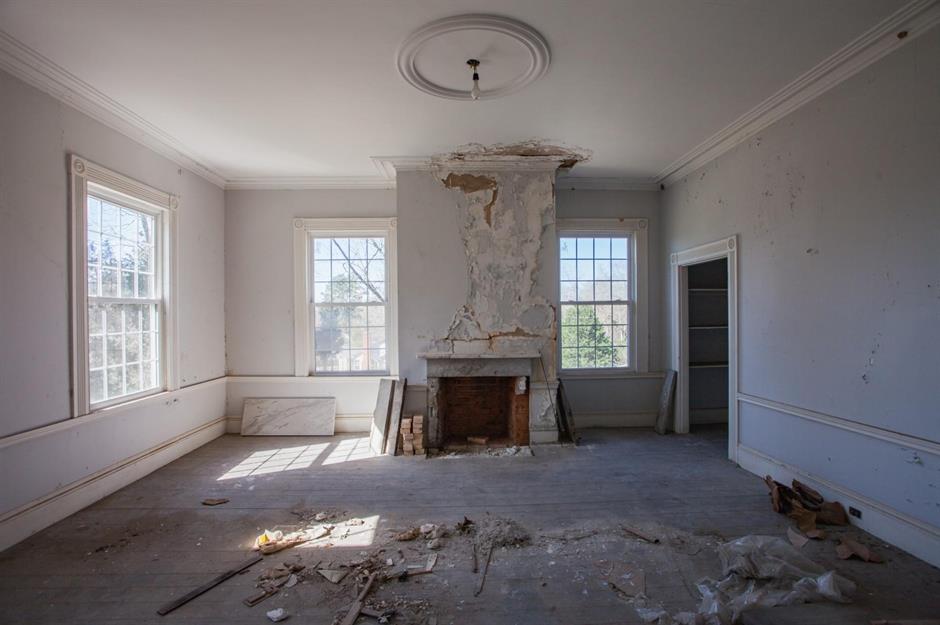
Unfortunately, over the years, the house fell victim to fire damage and water infiltration, as evident in the sorry state of the master bedroom shown in this picture. In the 1970s, its future hung in the balance when a local individual sought to buy and strip it of its remaining exquisite interior details. Thankfully, its inclusion in the National Register of Historic Places in 1978 prevented such pillaging, but the property continued to deteriorate.
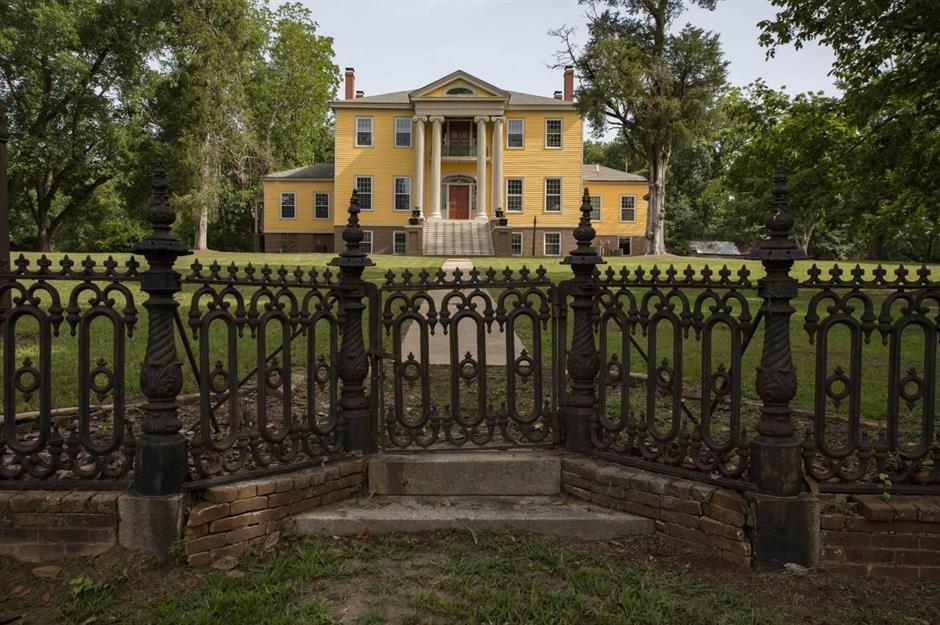
Fortunately, the fortunes of this southern beauty took a turn for the better when three investors decided to take on the challenge of restoring the mansion. And what a transformation it underwent! The sunny yellow exterior, true to its original colors as revealed by paint analysis and historic records, now shines bright. The once-dilapidated steps and imposing Ionic columns have been meticulously restored to their former glory.
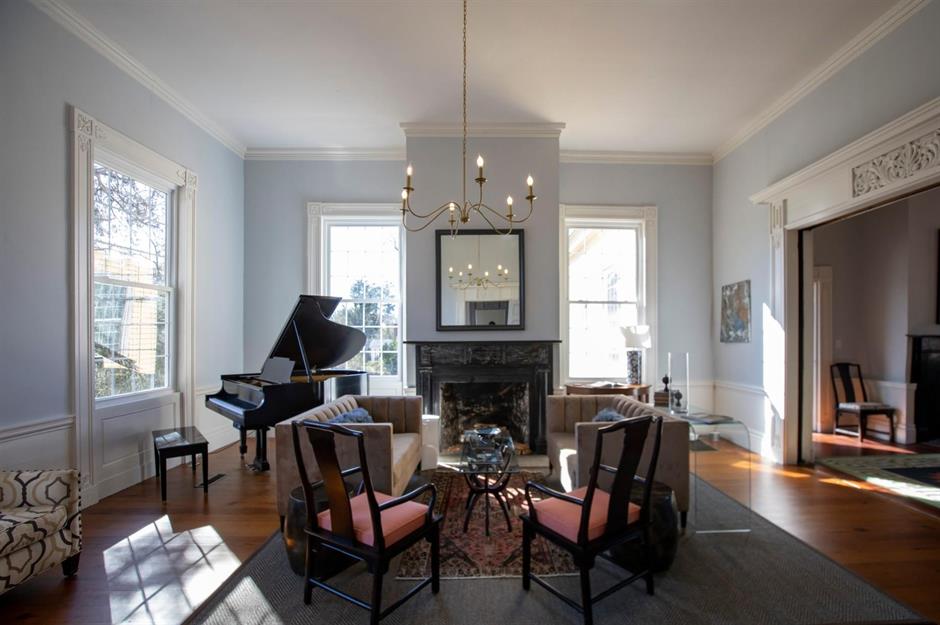
Inside, the renovated sitting room stands as a testament to sympathetic restoration, preserving all of its original features, including its magnificent tall sash windows. In 2019, Ross Sheppard, Jacob Hawkins, and Will Walker, all Georgia locals with a deep passion for historic homes, purchased the abandoned mansion for a steal at $350,000 (£303k). Sheppard, a realtor specializing in historic home preservation, led the charge.
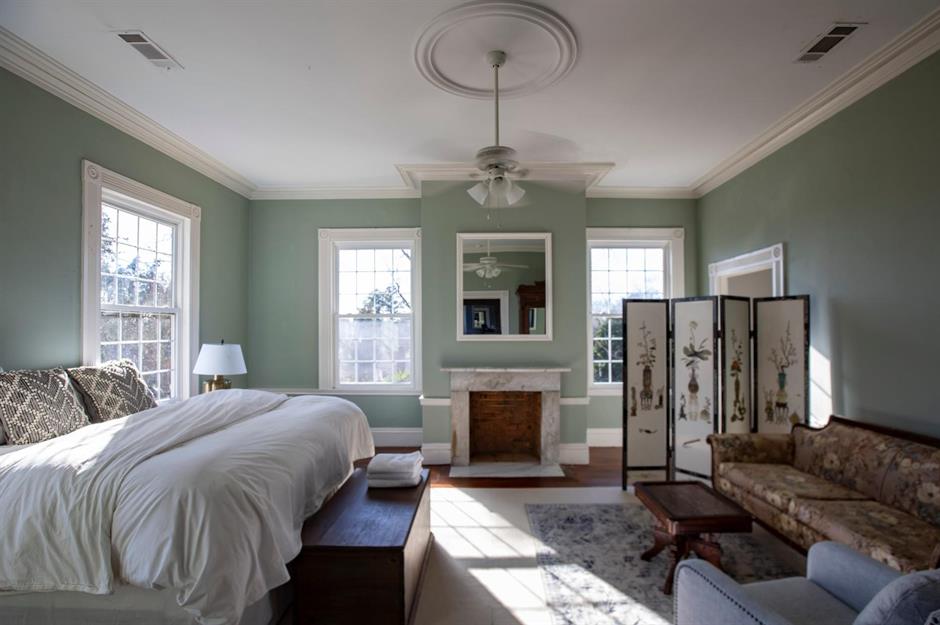
Take a look at the master bedroom’s incredible transformation! Once badly damaged, it’s now a sight to behold. Local mason Mr. Woodrow played a crucial role in restoring the room, carefully conserving its intricate cornicing over the sash windows. The team also received invaluable assistance from property conservation expert Kyle Campbell from Preservation South.
Be sure to check out the mansion’s website for more information.
Page Mansion
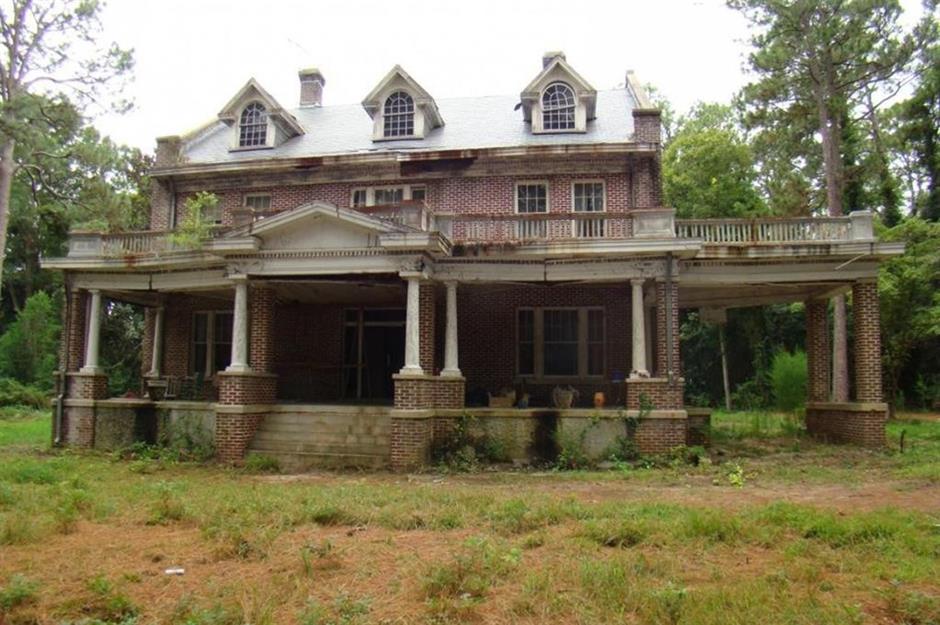
This North Carolina manor had been abandoned for nearly four decades, presenting a sorry sight to any passerby. The Page Mansion, a sprawling 6,000-square-foot Colonial-style brick house, was originally designed in 1913 for Frank Page, a timber tycoon. With its grand staircase, spacious parlors and dining rooms, six bedrooms, and servants’ quarters, it once epitomized opulence. However, the onset of the Great Depression dealt a devastating blow to its original owners, leading the mansion to fall into disrepair.
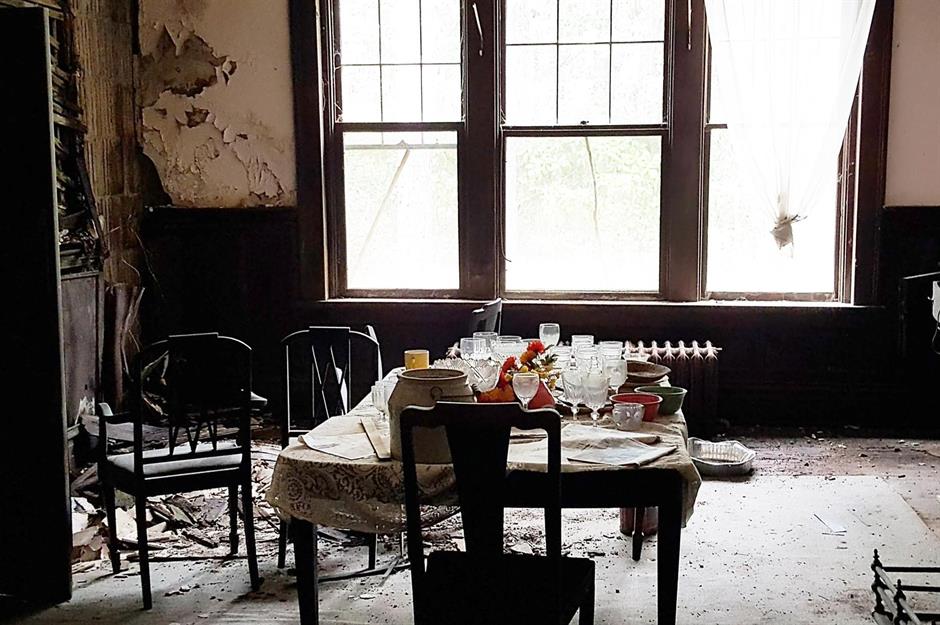
The dining room walls resembled the aftermath of a blast, crumbling away, while the table remained strangely untouched, still adorned with fine glassware. Fortunately, the Page Mansion found its saviors in Abby and Trey Brothers, a married couple on the lookout for a new home. Abby stumbled upon the listing on Zillow in April 2018, and by July of the same year, they had acquired it for a mere $155,000 (£134k).
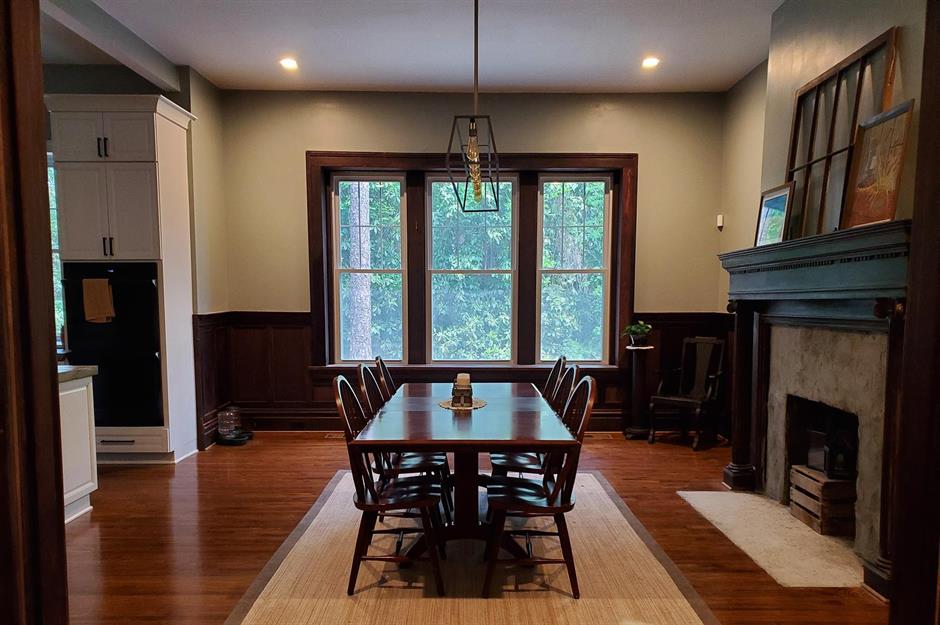
Opting for a more contemporary layout, Abby and Trey decided to tear down walls to create an open-plan space connecting the dining room to the kitchen. Despite this modernization, the dining room retains its traditional charm and original features, including a fireplace, while large sash windows flood the room with natural light.
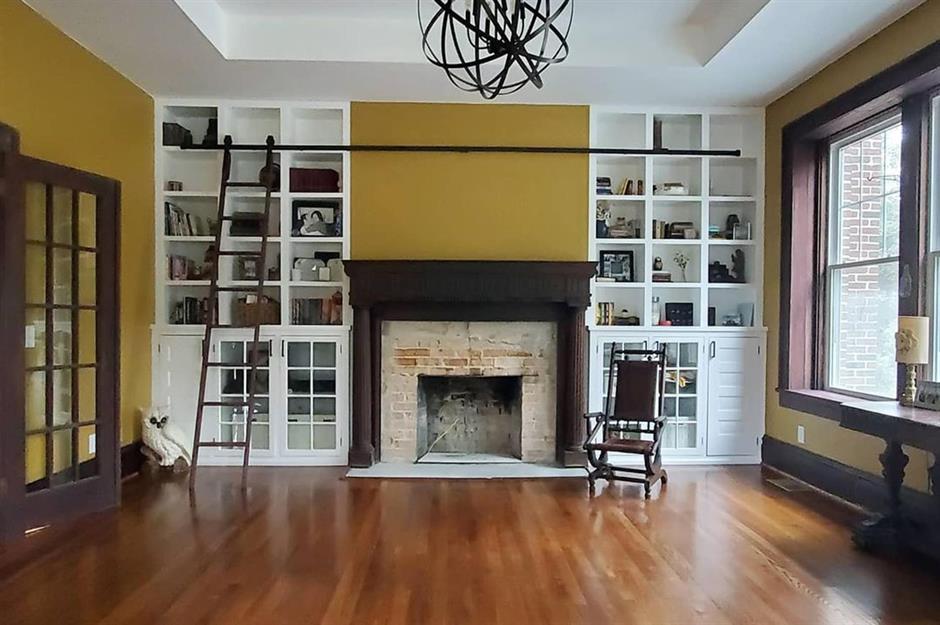
The study was buried under layers of grime, necessitating a complete overhaul. Now, it boasts a striking feature wall painted in a vibrant yellow ochre hue, complementing the original fireplace. The shelving and cabinets not only enhance the room’s aesthetics but also conceal modern plumbing and air conditioning units. A recessed ceiling adds to the sense of space while cleverly concealing pipework.
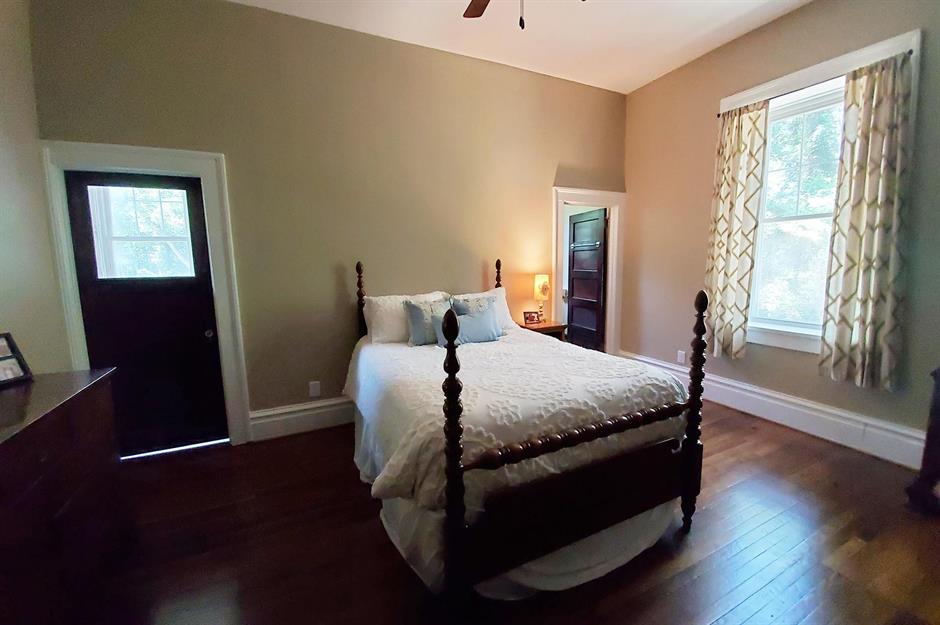
The master bedroom was once filled with rubble and debris, barely recognizable as a place for rest. However, Abby and Trey’s efforts have transformed it into a tranquil retreat, complete with a charming wooden bed frame. Despite encountering setbacks, including flooding from a hurricane, the couple persevered, turning this dilapidated structure into their cherished historic home. You can follow their inspiring journey on Instagram and Facebook.
McDonald House
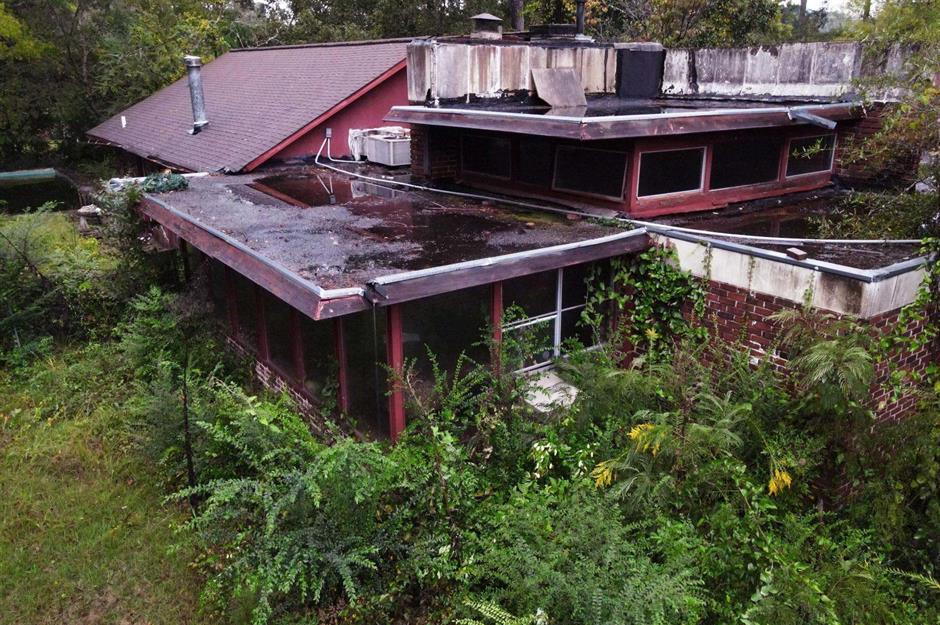
Back in its prime, this mid-century gem in Birmingham, Alabama epitomized the sleek modern design of the 1960s era. Designed by architect John Randal McDonald, the house was a testament to the era’s emphasis on spaciousness and connection with nature, often termed “organic architecture.” With its wide horizontal planes, expansive windows, and natural materials, it seamlessly integrated with its picturesque surroundings. McDonald envisioned affordable, informal living spaces for families, and his design principles reflected this.

Despite its former glory, the home fell into disrepair following the owner’s passing. Yet, even in its neglected state, one could still discern McDonald’s vision of open, light-filled living areas. His approach drew inspiration from the work of renowned architect Frank Lloyd Wright but offered more affordable alternatives, incorporating jutting rooflines, repeating rectangles, ribbon windows, and horizontal lines without the extravagant masonry or costly craftsmanship associated with Wright’s designs.
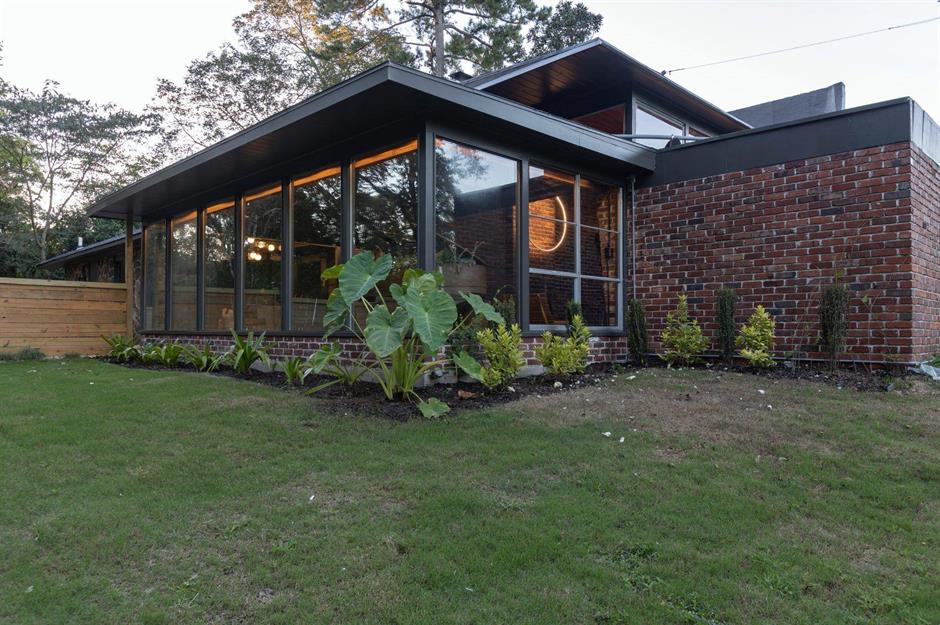
Thankfully, the home was saved from oblivion by local investors who recognized its potential. Built in 1960, the house retains its ultra-modern appeal, boasting restored window panes and a meticulously manicured lawn. The entire property was brought up to 2019 energy standards, with updated electrical wiring, plumbing, and a modern septic tank system.

Remaining faithful to McDonald’s original vision, the living room exudes relaxation, enveloping you in natural elements such as exposed brick and wood. The verdant green paint and expansive windows blur the lines between indoor and outdoor spaces, while a scoop rocking chair crafted from wooden slats completes the inviting ambiance. With a spacious 1,500-square-foot layout, the house offers an open living area, two bedrooms, two bathrooms, a family den, a walk-in closet, and a pantry.
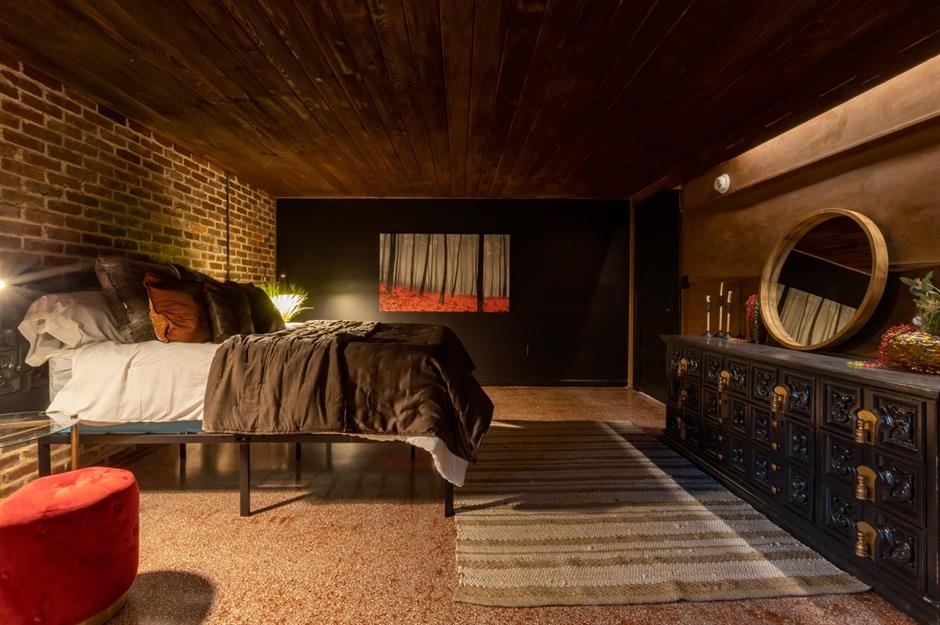
In the stylish master bedroom, dark wood accents create a distinctive aesthetic, while the low ceilings add a cozy vibe. A cleverly placed artwork at one end creates the illusion of a forest beyond the wall, enhancing the room’s charm. Thoughtful lighting design, including downlights and table lamps, adds ambiance without the need for a central fixture. Through meticulous restoration, the essence of McDonald’s original vision for the house was preserved, ultimately attracting a buyer who saw its value, fetching a price of $225,000 (£195k).
RECOMMENDED: Inside Creepy Abandoned Mansions Around The World
Arkansas Victorian House
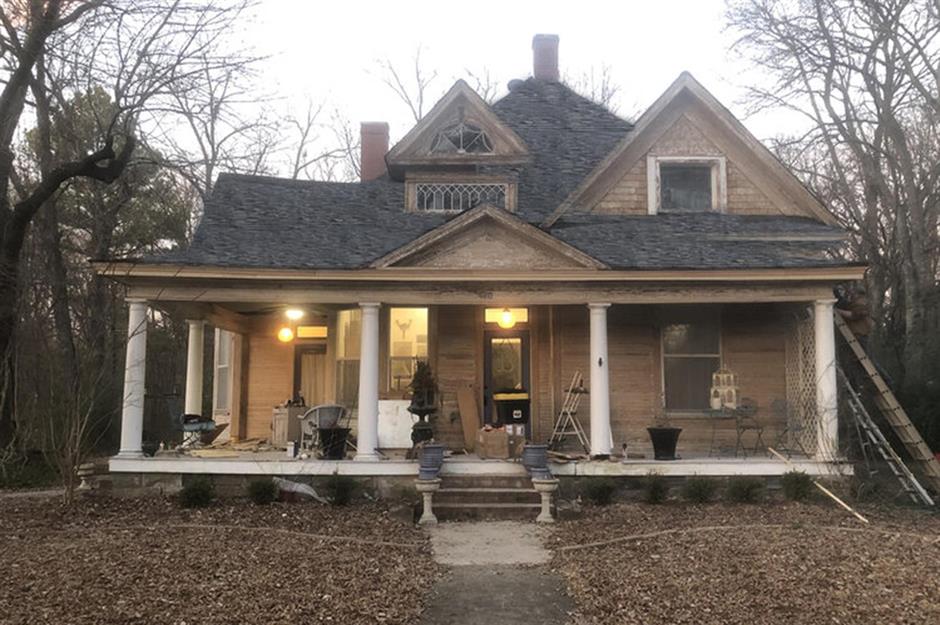
A stunning Victorian home, left to deteriorate for decades, captured the attention of passionate historic house restorers, Kevin and Laine Berry. For Laine, it was a childhood dream come true when she spotted the house for sale in 2011 for $106,000 (£92k) in her hometown of Conway, Arkansas, a place she had admired for years. However, after approximately 70 years of neglect, the house faced demolition due to extensive termite damage and dry rot in its foundations.
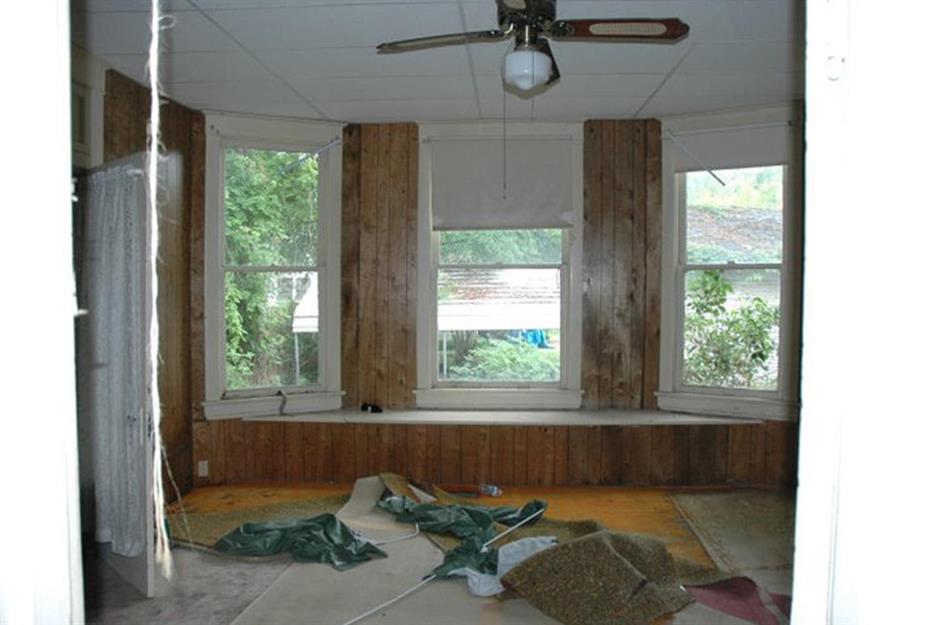
With experience renovating 20 heritage homes, Kevin and Laine were no strangers to turning fixer-uppers into gems, but this project presented a significant challenge. The living room lacked its original charm, with unsightly wood slats and ceiling tiles covering its potential. Built in 1909, the house underwent a peculiar journey in 1925 when it was lifted off its foundations, placed on logs, and pulled by mules across the block to be rotated 180 degrees into its final position!
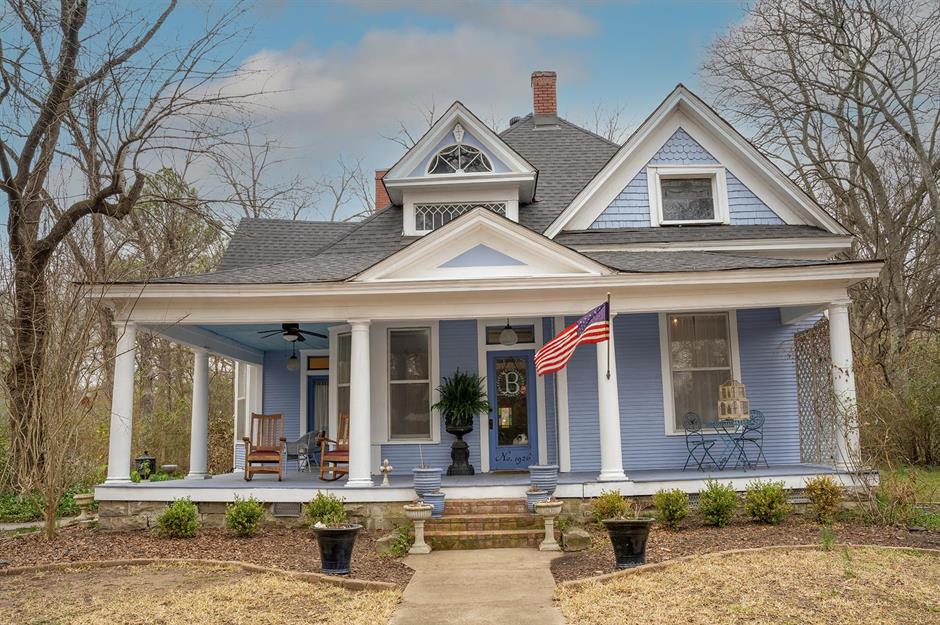
Their first major task was lifting the entire structure to address the rotten foundations, a daunting endeavor that proved worthwhile, albeit costly. The initial 16 months of the project amounted to an estimated $120,500 (£104k). The striking cornflower blue exterior paint adds to the house’s memorable charm.
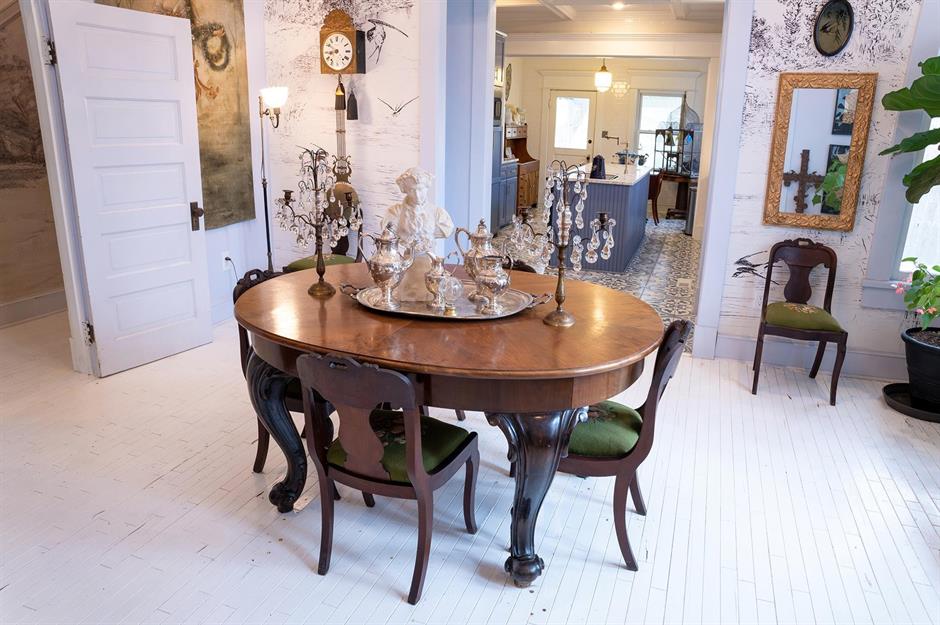
Throughout the renovation, the couple uncovered numerous hidden treasures, including 12-foot ceilings hidden under paneling, original eight-foot pocket doors tucked away in the garage, and a pristine kitchen sink salvaged from a garbage pile. The dining room, now restored to its grandeur, features floor-to-ceiling windows and is adorned with embroidered waistcoats and Laine’s grandmother’s china, lending an authentic historic ambiance to the interior.
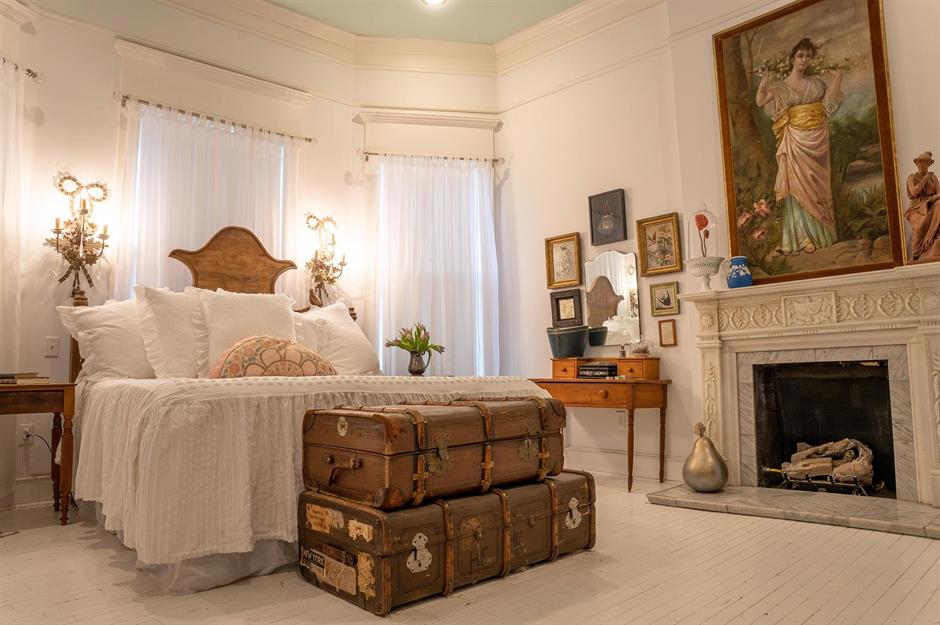
The bedroom boasts a dreamy color scheme complemented by intriguing antiques, such as vintage trunks by the bed. Despite facing termite damage in the back wall, the room was remodeled to perfection. To accommodate their rescue dogs, the couple applied a durable paint typically used for saltwater boats throughout the house, ensuring the floor remains pristine even with the pets’ playful antics. While Kevin and Laine juggle the restoration of several other historic properties, they have made this charming house their cherished home.
Château de la Motte Husson
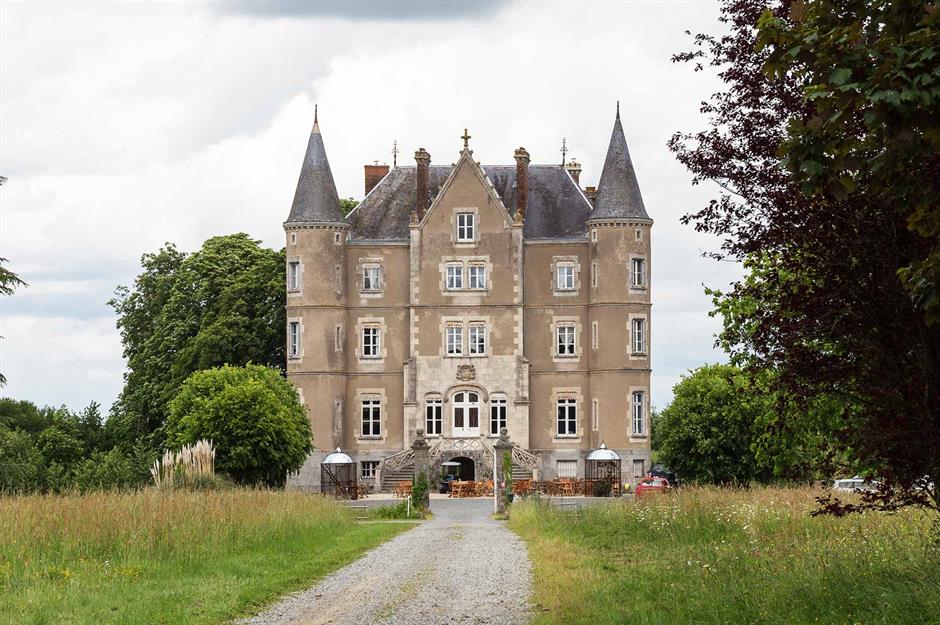
A derelict castle steeped in history proved to be the ultimate challenge for resourceful renovators Dick and Angel Strawbridge, whose restoration journey captured the hearts of viewers on the hit TV series Escape to the Château. Situated in Martigné-sur-Mayenne, France, the 19th-century castle became the Strawbridges’ ambitious project after they acquired it for a remarkably reasonable $404,000 (£350k). Despite its neo-Renaissance exterior appearing relatively well-preserved, the interior told a different story…
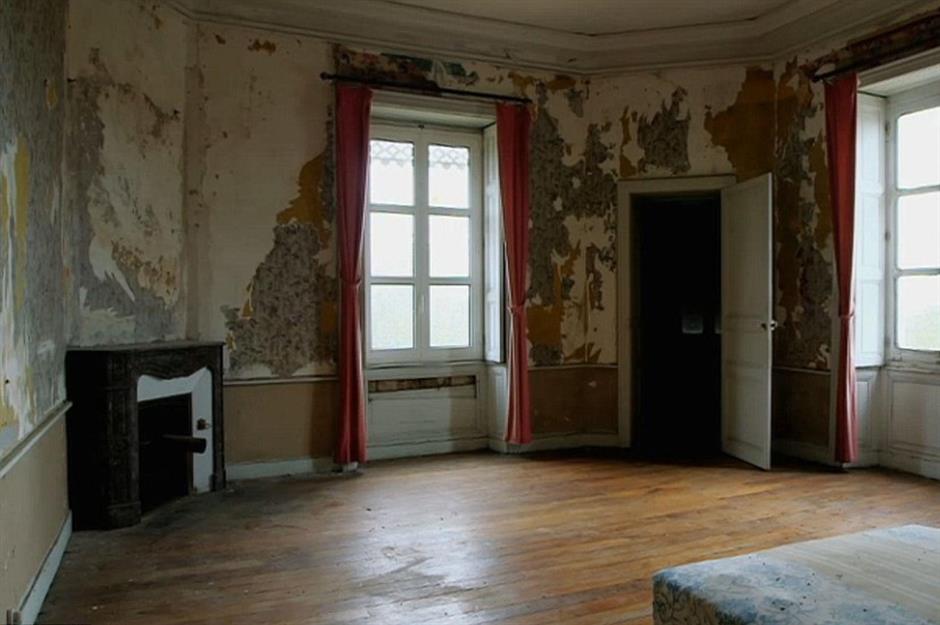
With crumbling walls, a leaky roof, and a lack of basic amenities such as heating, water, electricity, and sewerage, the task ahead was monumental—all within a tight renovation budget of $32,000 (£28k). Yet, amidst the decay, glimpses of potential shone through, like in this dilapidated room with its lofty ceiling, tall windows, and vintage fire surround, awaiting restoration. Dick, a former lieutenant colonel in the army, tackled much of the restoration work himself, impressively revitalizing the ceilings, walls, and floors in key areas like the dining room, kitchen, and main bedroom.
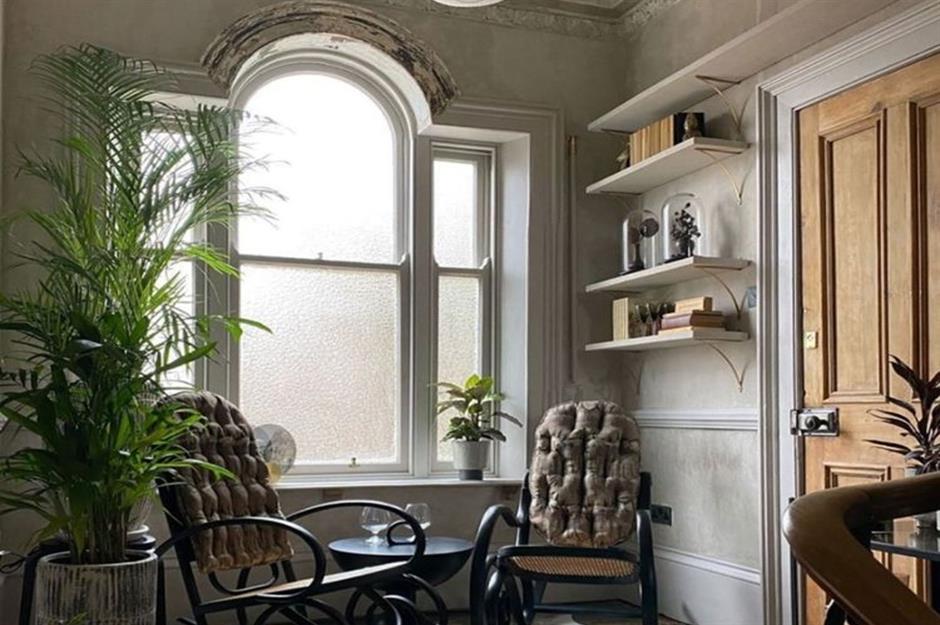
A highlight of the renovation is this inviting informal seating area dominated by a splendid Palladian window. By ingeniously repurposing a redundant space at the top of a staircase, the Strawbridges created a functional living area brimming with charm. Angel took charge of the interior design, infusing the space with quirky décor and sumptuous fabrics for a characterful style. She also lent her creative touch to many of the home’s finishes, from printing tiles to crafting wallpaper, all with an eye toward saving costs.
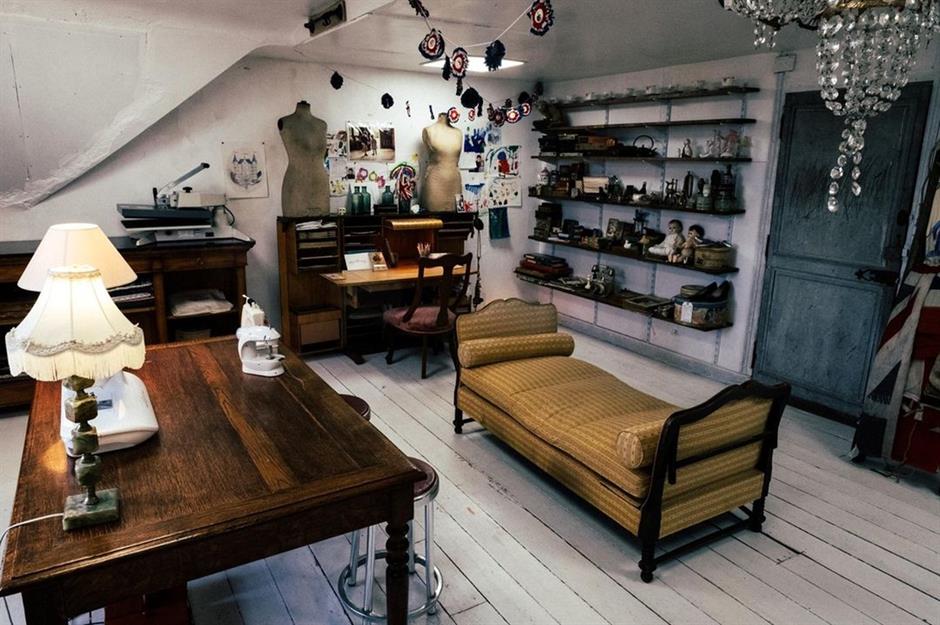
Here we see Angel’s transformed crafting room within the enchanting castle, where she works her magic crafting handmade accessories and home furnishings. Originally a fort belonging to the Husson family since 1406, the castle underwent extensive reconstruction in the 19th century, emerging as a grand residence complete with two imposing towers, a square moat, five floors, 47 rooms, an orangery, stable block, walled garden, and surrounded by 12 acres of parkland.
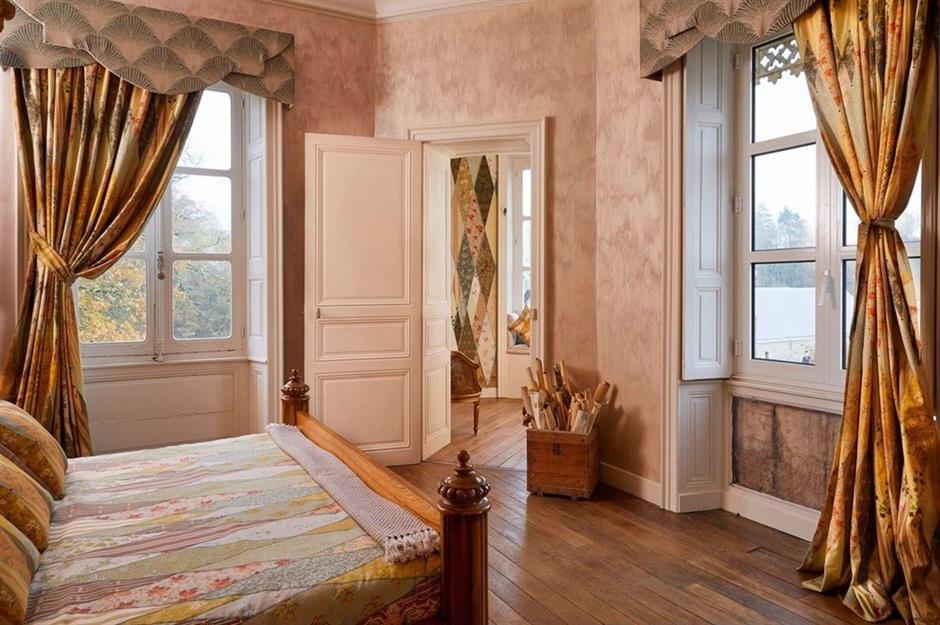
A cozy guest bedroom nestled within one of the towers benefits from an abundance of natural light streaming in through multiple windows, accentuated by the angular shape of the room. Floor-length sweeping curtains add a touch of drama to this visually captivating space. After five years of dedicated renovation efforts, the château now serves as the Strawbridges’ cherished family home and a thriving wedding venue—a testament to their unwavering commitment and vision. Truly breathtaking! Follow their inspiring journey for more insights.
Oscar Mayer Mansion
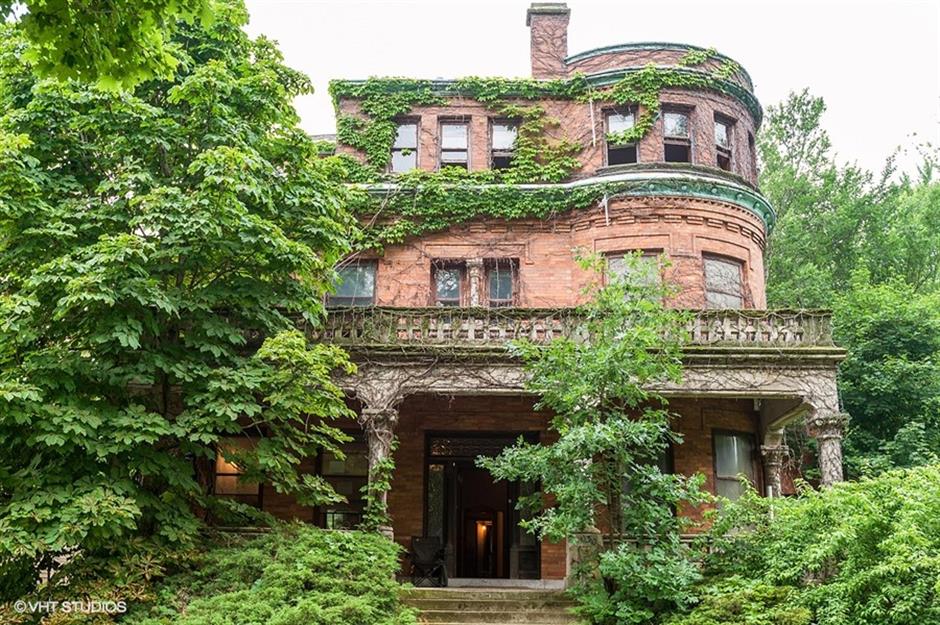
Amidst lush foliage stands a remarkable Romanesque Revival-style brick mansion in Evanston, Illinois’ historic Lakeshore District. Originally constructed in 1901 by Swedish architect Lawrence Gustav Hallberg, the mansion boasts striking features including a distinctive round tower, sturdy walls, and a majestic colonnaded porch. Purchased by Oscar G. Mayer, son of meat-packing tycoon Oscar F. Mayer, in 1927, the mansion remained an iconic landmark.
.jpg)
However, by 2015, the mansion had languished empty and neglected for a decade, with local rumors suggesting it was haunted. Despite its eerie reputation, the mansion exuded great potential, evident even before renovation, with its intricately patterned windows framing the entrance. Acquired by real estate attorney Scott Hargadon and business partner James Kastenholz, the duo embarked on a mission to rescue the property and honor its rich history.
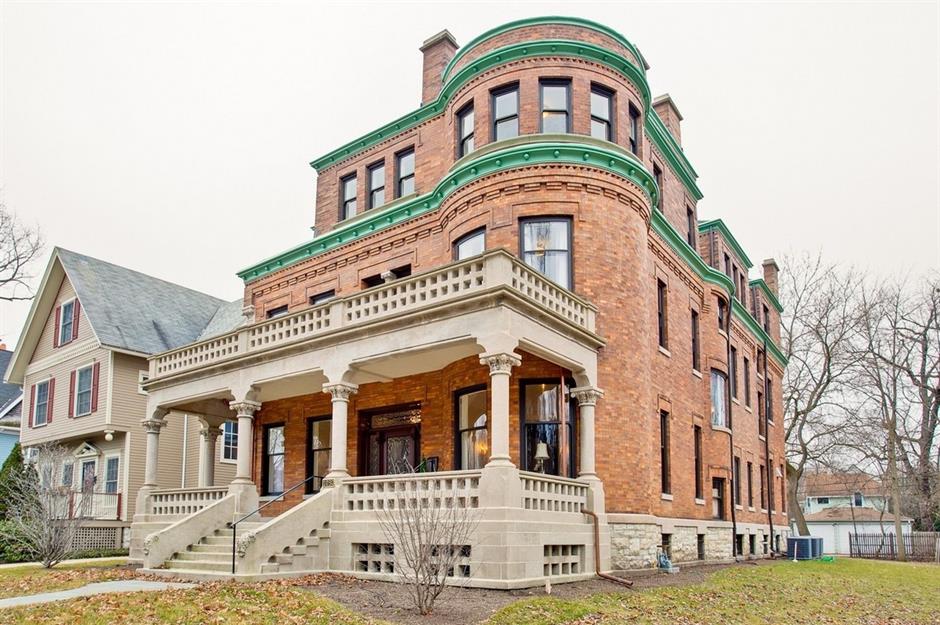
After extensive restoration efforts, the mansion’s grandeur was unveiled, with the portico beautifully restored and the building’s unique curved shape fully revealed. The meticulous renovation, costing over $1 million (£867k), addressed foundational issues, roof repairs, plumbing updates, and restoration of the stunning stained-glass windows. The property’s former owner, Oscar G. Mayer, left behind a significant legacy upon his passing in 1965, with the majority of his wealth allocated to a charitable trust.
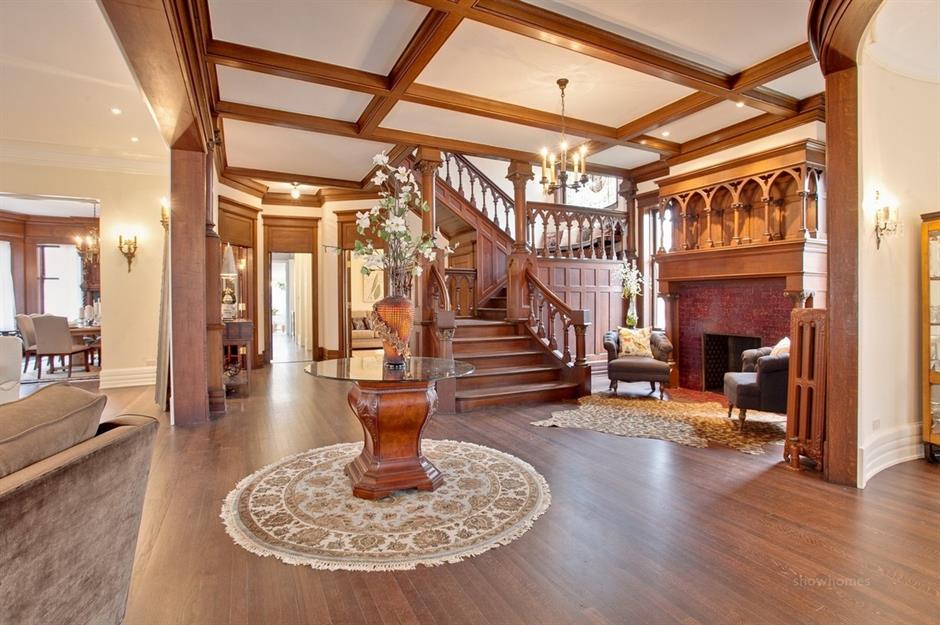
Throughout the renovation, the mansion’s exquisite original woodwork was meticulously preserved, including the intricately arched arcades adorning the fireplace and the dramatic twisting staircase, characteristic of the Romanesque Revival style. The wood-coffered ceiling adds a touch of regal elegance to the space, highlighting its historic charm.
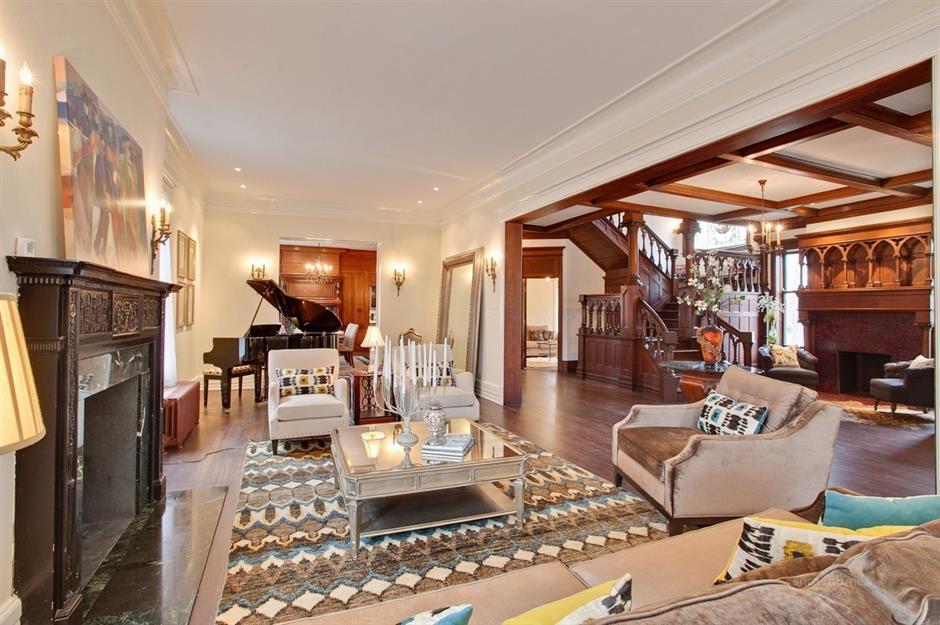
Modern comforts seamlessly blend with the old-world charm in the open-plan living room, adorned with finely carved original fireplace surrounds. Spanning three floors, the mansion features six bedrooms, five bathrooms, a chef’s kitchen with a walk-in pantry, a music room, game room, panelled library, and a ballroom. Original hardwood floors, lovingly restored, grace each room.
The revitalized property, marketed by Baird and Warner, found a new family to cherish its magnificence, selling for $1.7 million (£1.5m) in 2018. Now, a new chapter begins for this splendid old mansion, as a new family embarks on the journey of making it their home.
Kilmartin Castle
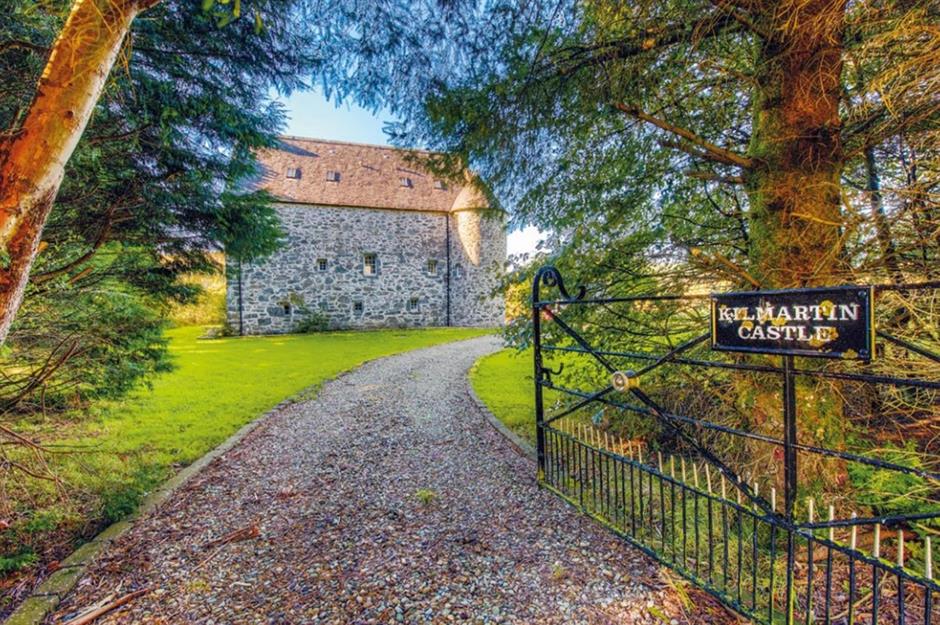
Revitalizing a weathered 16th-century fortress proved to be a monumental endeavor for Stef Burgeon and Simon Hunt, a married couple with a passion for restoration. Nestled along the breathtaking west coast of Scotland in Argyll & Bute, Kilmartin Castle stands as a remarkable Z-plan tower house, characterized by its main three-story block and projecting round towers at opposite corners. Enchanted by Scotland’s beauty during a holiday, Steph stumbled upon a listing for the castle, priced at $432,000 (£375k), prompting them to embark on a daring adventure.
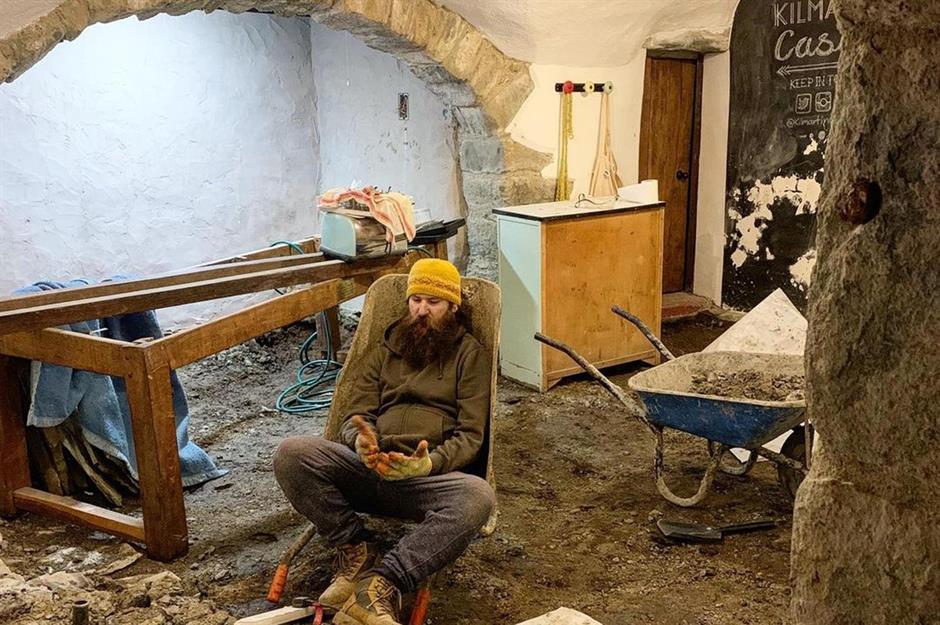
Upon acquiring the fortress, confronting damp patches on the ground floor necessitated lifting the original flagstone tiles for inspection—a painstaking task that consumed eight weeks of Simon’s efforts. Beneath the surface, they uncovered leaking fertiliser bags, hastily employed to combat dampness. Following expert advice, they excavated a foot to install modern insulation and underfloor heating before reinstating the floor. Today, the once dilapidated fortress boasts a cozy ambiance, offering respite from the elements.
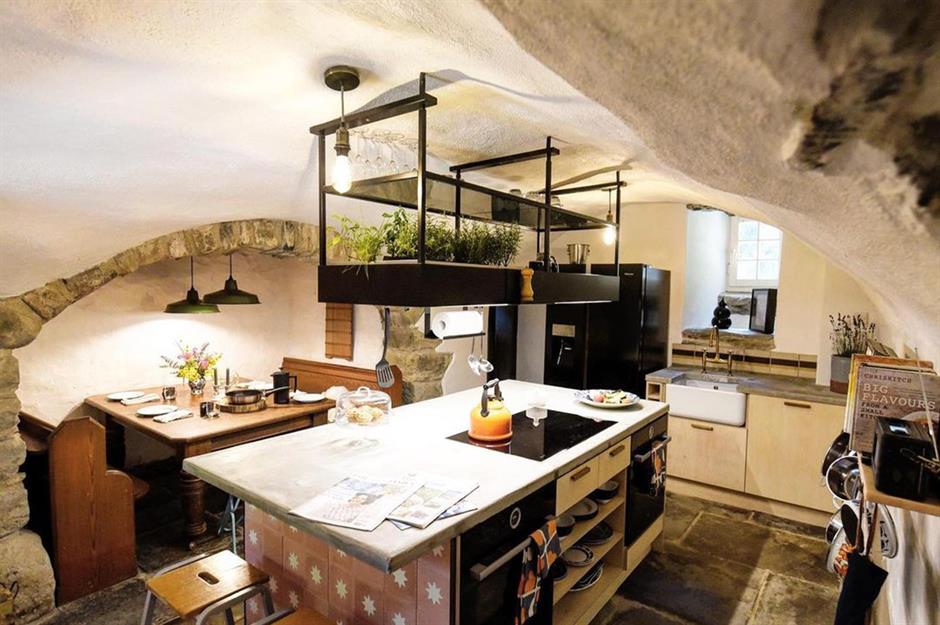
In the newly transformed kitchen, the rugged stone walls cocoon the space, seamlessly blending with modern amenities while preserving the castle’s innate character. The grand original fireplace now serves as a charming seating booth, featuring reclaimed tables and benches from an old pub. A central island adorned with two ovens and an inventive herb garden suspended from the ceiling add to the kitchen’s allure. Notably, fire-safe doors for the main entrance were crafted by Broadleaf Timber, the artisans behind the castle doors at Disneyland Paris—an exquisite touch.
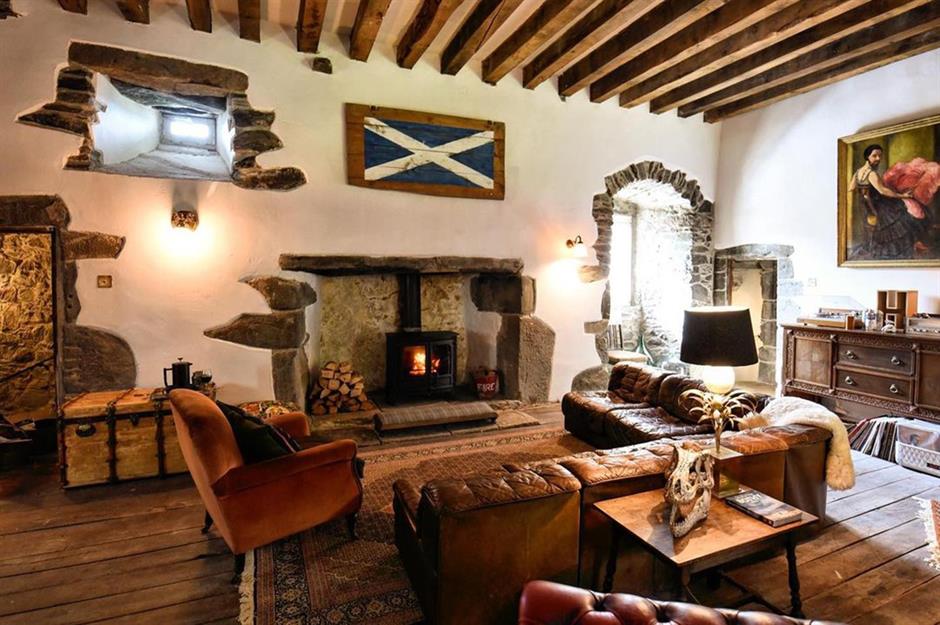
Exposed original stonework surrounding the windows and fireplace in the living room accentuates the fortress’s 500-year-old thick stone walls, transforming them into decorative focal points. Beautiful wooden ceiling beams enhance the room’s historic charm, reminiscent of its past inhabitants, including John Carswell, a prominent Protestant reformer during Mary Queen of Scots’ reign, and the Campbell Clan, who held the castle for two centuries.
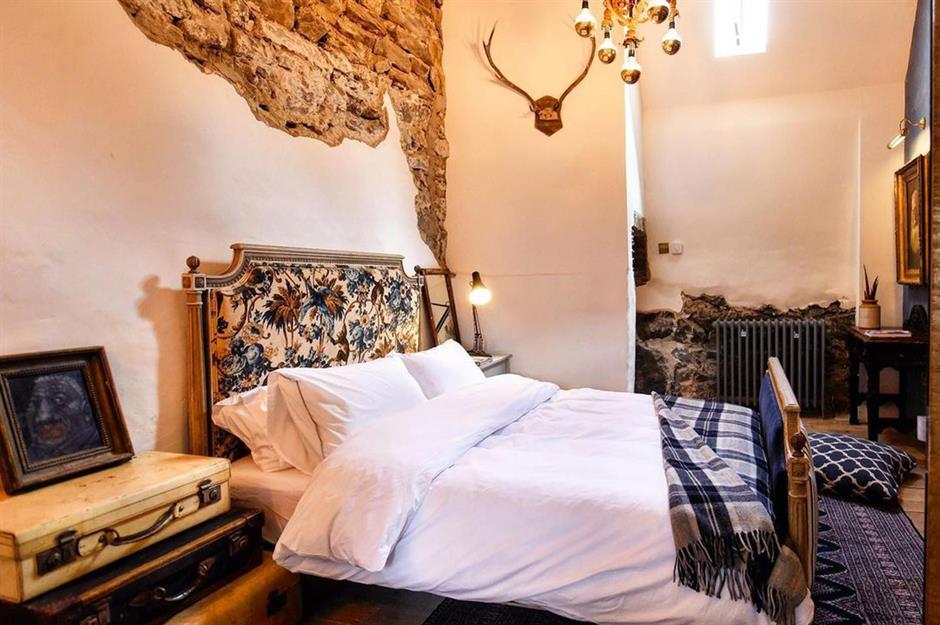
In the renovated bedroom, a striking feature wall reveals the original stone beneath lime plasterwork, evoking an old-world ambiance. Heritage-design fabrics adorning the headboard and throw add a touch of elegance to the cozy space. The upper floor, once shrouded in decaying carpeting, now showcases sturdy floorboards, a testament to Stef and Simon’s meticulous restoration efforts. After seven years of dedication, they successfully transformed the 500-year-old fortress into a luxurious boutique hotel, a testament to their unwavering commitment to preserving history.
RECOMMENDED: Abandoned Stunning European Mansions And Castles For Sale